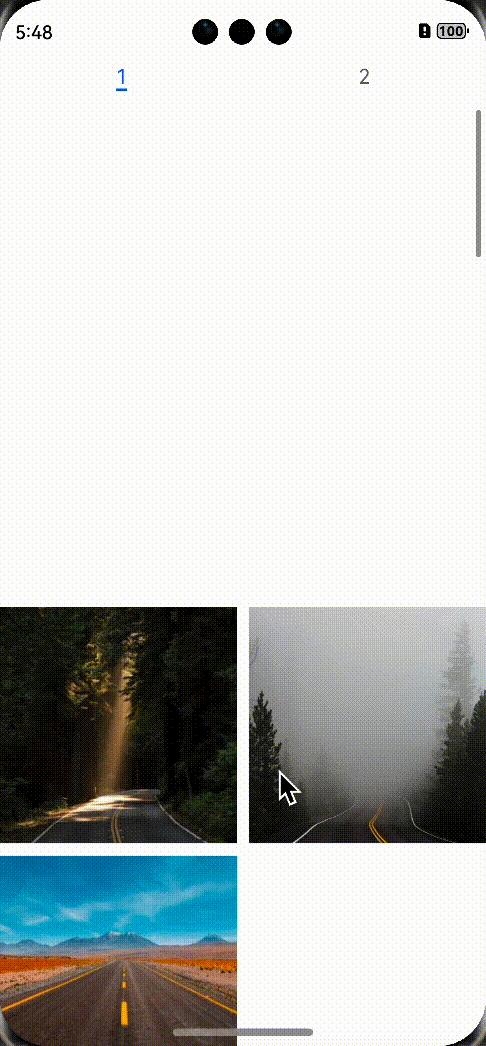今天分享的内容是懒加载。先跟初学者友友介绍一下什么是懒加载,以及为什么要使用懒加载。
懒加载是一种延迟加载技术,它允许在需要时才加载资源,如对象或数据,以提高系统性能和资源利用率。这样介绍比较抽象,举一个例子,当一个页面中加载大量图片时,下面分别是不使用懒加载和使用懒加载的效果:
不使用懒加载:
使用懒加载:
明显看出使用懒加载加载速度更快,用户体验更佳,因为懒加载是先加载屏幕中正在展示的数据。
在鸿蒙开发中,懒加载的使用方式一般是使用LazyForEach代替ForEach,但是数据源不能是通常的数组了,而是IDataSource类型,并且需要实现相关接口,下面是上文示例中的相关代码:
class WaterFlowDataSource implements IDataSource {
private dataArray: Object[] = []
private listeners: DataChangeListener[] = []
constructor() {
let data = getContext(this).resourceManager.getRawFileContent('images.json',(err,value)=> {
let view: Uint8Array = new Uint8Array(value); // 使用Uint8Array读取arrayBuffer的数据
let textDecoder: util.TextDecoder = util.TextDecoder.create(); // 调用util模块的TextDecoder类
let res: string = textDecoder.decodeWithStream(view); // 对view解码
let strArr:object[] = JSON.parse(res)
for (let i = 0; i < strArr.length; i++) {
this.dataArray.push(strArr[i])
}
this.notifyDataReload()
})
}
// 获取索引对应的数据
public getData(index: number): Object {
return this.dataArray[index]
}
// 通知控制器数据重新加载
notifyDataReload(): void {
this.listeners.forEach(listener => {
listener.onDataReloaded()
})
}
// 通知控制器数据增加
notifyDataAdd(index: number): void {
this.listeners.forEach(listener => {
listener.onDataAdded(index)
})
}
// 通知控制器数据变化
notifyDataChange(index: number): void {
this.listeners.forEach(listener => {
listener.onDataChanged(index)
})
}
// 通知控制器数据删除
notifyDataDelete(index: number): void {
this.listeners.forEach(listener => {
listener.onDataDeleted(index)
})
}
// 通知控制器数据位置变化
notifyDataMove(from: number, to: number): void {
this.listeners.forEach(listener => {
listener.onDataMoved(from, to)
})
}
// 获取数据总数
public totalCount(): number {
return this.dataArray.length
}
// 注册改变数据的控制器
registerDataChangeListener(listener: DataChangeListener): void {
if (this.listeners.indexOf(listener) < 0) {
this.listeners.push(listener)
}
}
// 注销改变数据的控制器
unregisterDataChangeListener(listener: DataChangeListener): void {
const pos = this.listeners.indexOf(listener)
if (pos >= 0) {
this.listeners.splice(pos, 1)
}
}
// 增加数据
public Add1stItem(): void {
this.dataArray.splice(0, 0, this.dataArray.length)
this.notifyDataAdd(0)
}
// 在数据尾部增加一个元素
public AddLastItem(): void {
this.dataArray.splice(this.dataArray.length, 0, this.dataArray.length)
this.notifyDataAdd(this.dataArray.length-1)
}
// 在指定索引位置增加一个元素
public AddItem(index: number): void {
this.dataArray.splice(index, 0, this.dataArray.length)
this.notifyDataAdd(index)
}
// 删除第一个元素
public Delete1stItem(): void {
this.dataArray.splice(0, 1)
this.notifyDataDelete(0)
}
// 删除第二个元素
public Delete2ndItem(): void {
this.dataArray.splice(1, 1)
this.notifyDataDelete(1)
}
// 删除最后一个元素
public DeleteLastItem(): void {
this.dataArray.splice(-1, 1)
this.notifyDataDelete(this.dataArray.length)
}
// 重新加载数据
public Reload(): void {
this.dataArray.splice(1, 1)
this.dataArray.splice(3, 2)
this.notifyDataReload()
}
}
class MyDataSource extends WaterFlowDataSource {
private dataArray2: Object[] = [];
public totalCount(): number {
return this.dataArray2.length;
}
public getData(index: number): Object {
return this.dataArray2[index];
}
public addData(index: number, data: Object): void {
this.dataArray2.splice(index, 0, data);
this.notifyDataAdd(index);
}
public pushData(data: Object): void {
this.dataArray2.push(data);
this.notifyDataAdd(this.dataArray2.length - 1);
}
}
实现懒加载:
@State dataSource: WaterFlowDataSource = new WaterFlowDataSource()
Grid(){
LazyForEach(this.dataSource,(item:object,index:number)=>{
GridItem(){
Image(this.imageURL + item['cover'])
.width((this.screen_width - 10)/2)
.height((this.screen_width - 10)/2)
}
})
}
.columnsTemplate('1fr 1fr')
.columnsGap(10)
.rowsGap(10)
.width('100%')
.height('100%')
关于鸿蒙开发懒加载的内容就是这样,祝大家学习顺利。






Top comments (0)